
Welcome to springfieldsnakes.com! I am David, a snake enthusiast living in Springfield, MA. Many people don't know that Springfield is in fact full of snakes! You just need to know where to find them - they can often be shy and elusive. Some Massachusetts snake species are more common outside of the city limits, in different parts of Hampden County MA, but many types of snakes are indeed common in the more urban parts of Springfield. This guide is meant to help educate you about the beautiful snakes of Springfield, and to help you identify the most common snakes of Springfield, as well as the venomous snakes of Springfield that you should learn to recognize and avoid. If you want more detail, click here for my complete list of ALL snake species in Springfield. Remember the following:
- Most snakes of Springfield are harmless and don't want to encounter you
- Venomous snakes exist but are uncommon in Springfield, Massachusetts
- Snakes eat rats and mice and are a valuable part of the Massachusetts ecosystem
- Never kill a snake - if you leave a snake alone, it will leave you alone.
Common Snake Species in Springfield
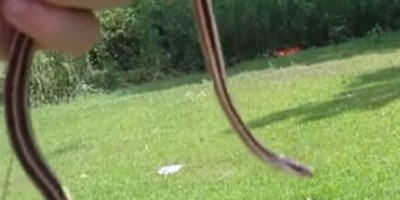 Eastern Ribbon Snake:
Appearance: The eastern ribbon snake is a thin-bodied snake with keeled scales. Besides that, it has a dull brown body marked with black and yellow stripes at the back. A white band also appears in the eye—the unique identifying feature. Typically, it measures 20-28 inches long.
Habitat: This snake loves wetlands like ponds and streams to get food like fish and amphibians. The waters around also serve as cooling areas during hot periods.
Behavior: The eastern ribbon snake is photophilic. So, it's always alert during the day and goes hunting for its meals in the daylight. This reptile hibernates in winter and resurfaces in spring for mating, while their young ones are born towards the end of summer.
Eastern Ribbon Snake:
Appearance: The eastern ribbon snake is a thin-bodied snake with keeled scales. Besides that, it has a dull brown body marked with black and yellow stripes at the back. A white band also appears in the eye—the unique identifying feature. Typically, it measures 20-28 inches long.
Habitat: This snake loves wetlands like ponds and streams to get food like fish and amphibians. The waters around also serve as cooling areas during hot periods.
Behavior: The eastern ribbon snake is photophilic. So, it's always alert during the day and goes hunting for its meals in the daylight. This reptile hibernates in winter and resurfaces in spring for mating, while their young ones are born towards the end of summer.
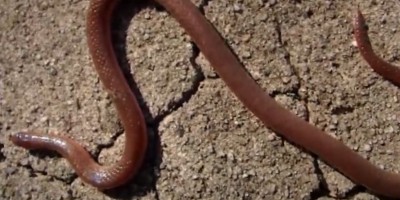 Eastern Worm Snake:
Appearance: Just like the name suggests, the eastern worm snake looks like a worm. It's small, slim, and grows to about 7 to 14 inches long. The reptile has a small, flat head with small eyes. Moreover, its body is brown to gray with a sharp tail and smooth scales.
Habitat: Eastern worm snake loves moist areas; near gardens or in deciduous woodlands. They feed on worms and other insects.
Behavior: This snake species is most active from May to September and inactive during cold months. During its dormant months, all activities like reproduction cease but resume in autumn and spring.
Eastern Worm Snake:
Appearance: Just like the name suggests, the eastern worm snake looks like a worm. It's small, slim, and grows to about 7 to 14 inches long. The reptile has a small, flat head with small eyes. Moreover, its body is brown to gray with a sharp tail and smooth scales.
Habitat: Eastern worm snake loves moist areas; near gardens or in deciduous woodlands. They feed on worms and other insects.
Behavior: This snake species is most active from May to September and inactive during cold months. During its dormant months, all activities like reproduction cease but resume in autumn and spring.
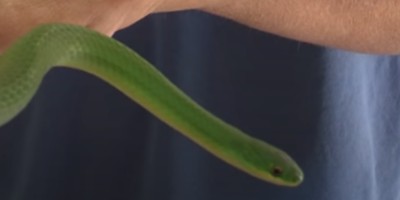 Smooth Green Snake:
Appearance: The smooth green snake has a slim body that measures 12-26 inches long. It has a pure green back and a yellow to white abdomen with soft scales.
Habitat: This snake loves the edges of forests, grassy hilltops, open woodlands, and old fields. It feeds on insects like crickets, grasshoppers, and other arthropods like spiders.
Behavior: Due to its color, this green reptile camouflages with green vegetation to hunt for insects. You should be careful when walking in such areas.
Smooth Green Snake:
Appearance: The smooth green snake has a slim body that measures 12-26 inches long. It has a pure green back and a yellow to white abdomen with soft scales.
Habitat: This snake loves the edges of forests, grassy hilltops, open woodlands, and old fields. It feeds on insects like crickets, grasshoppers, and other arthropods like spiders.
Behavior: Due to its color, this green reptile camouflages with green vegetation to hunt for insects. You should be careful when walking in such areas.
Venomous Snake Species in Springfield
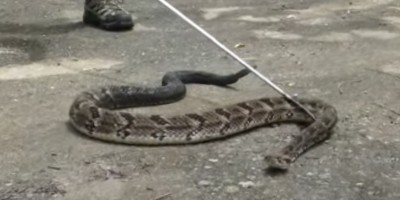 Timber Rattlesnake:
Appearance: The timber rattlesnake has a gray body with a yellow, black, brown, or pink band at the back. Its body length ranges from 35 to 60 inches. This type of snake is keel-scaled and has a pronounced rattle tail.
Habitat: This creature lives in bedrock crevices, fields, and forests. It is ectothermic and would also prefer areas where it can bask. Such include woodpiles and rocks. Its main sources of food include lizards, rodents, and insects.
Behavior: Timber rattlesnakes are diurnal during fall and spring. However, during the excess heat of summer, it goes dormant during the day and carries out its activities at night. Unlike other snake species, a timber rattlesnake doesn't hunt. Instead, it coils and hides behind logs to catch moving prey. This snake never bites unless under extreme circumstances.
Timber Rattlesnake:
Appearance: The timber rattlesnake has a gray body with a yellow, black, brown, or pink band at the back. Its body length ranges from 35 to 60 inches. This type of snake is keel-scaled and has a pronounced rattle tail.
Habitat: This creature lives in bedrock crevices, fields, and forests. It is ectothermic and would also prefer areas where it can bask. Such include woodpiles and rocks. Its main sources of food include lizards, rodents, and insects.
Behavior: Timber rattlesnakes are diurnal during fall and spring. However, during the excess heat of summer, it goes dormant during the day and carries out its activities at night. Unlike other snake species, a timber rattlesnake doesn't hunt. Instead, it coils and hides behind logs to catch moving prey. This snake never bites unless under extreme circumstances.
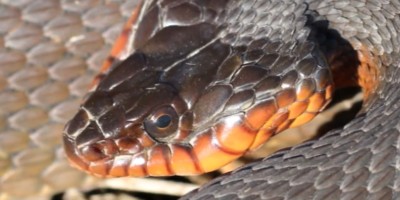 Northern Copperhead:
Appearance: The northern copperhead’s head and body are copper-colored. However, the body has brown hourglass-shaped stripes. Its body length ranges from 24 to 36 inches though it can grow up to 53 inches.
Habitat: This snake species lives in hilly forests and rocky areas. In addition to that, it prefers wetlands, especially during hot summers for swimming. Birds, small snakes, and frogs form part of their diet.
Behavior: Copperheads are nearly nocturnal; in that they resume their activities in the evenings towards darkness. Moreover, they go dormant in winter and resurface in spring to mate.
Text about snake 2. Text about snake 2. Text about snake 2. Text about snake 2. Text about snake 2. Text about snake 2. Text about snake 2.
Northern Copperhead:
Appearance: The northern copperhead’s head and body are copper-colored. However, the body has brown hourglass-shaped stripes. Its body length ranges from 24 to 36 inches though it can grow up to 53 inches.
Habitat: This snake species lives in hilly forests and rocky areas. In addition to that, it prefers wetlands, especially during hot summers for swimming. Birds, small snakes, and frogs form part of their diet.
Behavior: Copperheads are nearly nocturnal; in that they resume their activities in the evenings towards darkness. Moreover, they go dormant in winter and resurface in spring to mate.
Text about snake 2. Text about snake 2. Text about snake 2. Text about snake 2. Text about snake 2. Text about snake 2. Text about snake 2.
If you're unsure, you can email me a photo of the snake at info@springfieldsnakes.com and I will email you back with the snake's species. If you found a snake skin, read my Found a Skin? page, and you can email me a photo of the skin, and I'll identify the snake for you. If you need professional Springfield snake removal help, click my Get Help page, or see the below website sponsor I found, who provides that service.
Remember, the term is not poisonous snakes of Springfield, it's venomous snakes of Springfield. Poison is generally something you eat, and venom is injected into you. That said, dangerous snakes are very rare in Springfield. The few venomous snakes of Hampden County are rarely seen. But they are commonly misidentified, so learn about all the snake species of Springfield in order to correctly identify them. These snakes are usually also found in the surrounding towns of Wilbraham, Southwick, Chicopee, Holyoke, Springfield, Westfield, East Longmeadow, Agawam, Ludlow, West Springfield, Longmeadow, Palmer, Monson, Brimfield, Blandford, Granville, Tolland, Chester, Russell, Wales, Montgomery, Holland, and the surrounding areas.
Read our article about:
Do snakes run out of venom?
springfieldsnakes.com domain and hosting costs made possible by the generous support of this sponsor:
